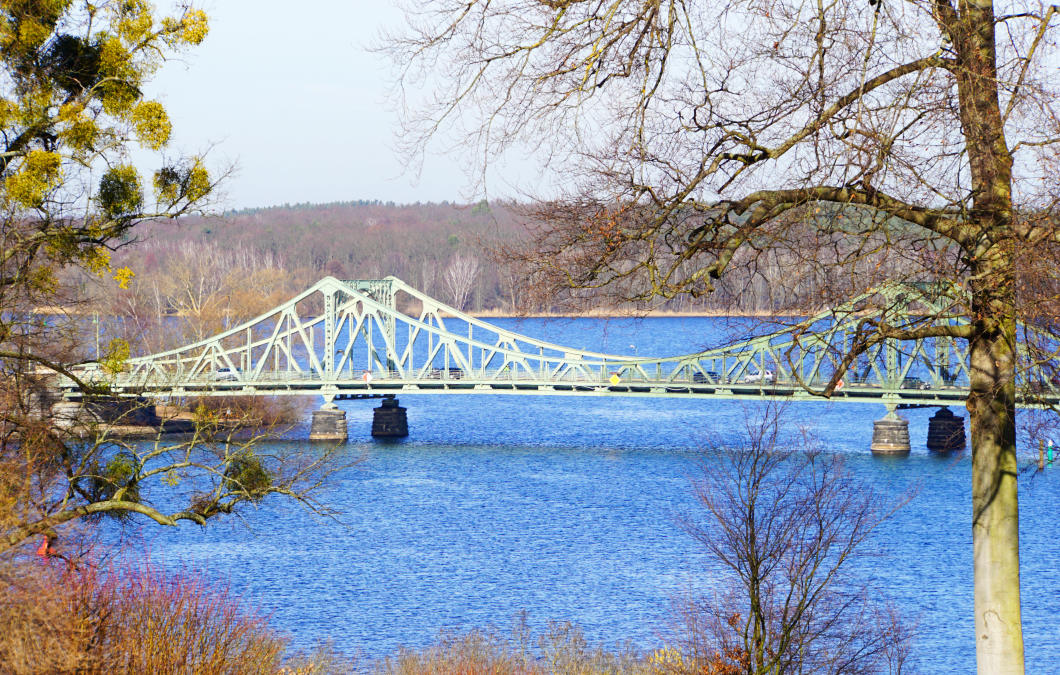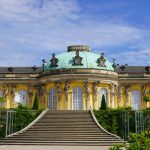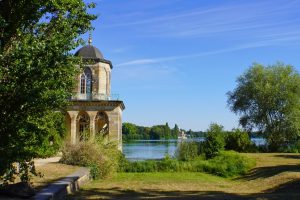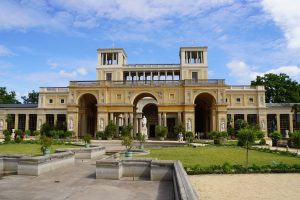Holger from Berlins Taiga invited me to an extraordinary guided tour with the theme “Park Babelsberg in the shadow of world history” and I was really excited about what to expect.
I had already taken a guided tour with Berlins Taiga and got an insight into the Glienicker Brücke. This tour was for me as a West Berlin child really something special, because I now got an impression of the for me at that time only difficult to reach half of Berlin. Whether I should hear now also unknown or forgotten stories on this guidance? In any case, according to the announcement, it should focus on the time after the Second World War – I was curious.
How was Park Babelsberg created?
Like every prince, Prince Wilhelm wanted to own his own castle. In 1833, Schinkel was able to start planning the palace and Lenné the garden. Unfortunately, money was very tight and so Lenné’s progress with the garden design was very slow. In addition, the poorly water-retaining soil and great heat frustrated many of his efforts. After conflicts with Princess Augusta, he was finally dismissed.

In 1843, Prince Pückler-Muskau took over the work in the garden complex. He retained parts of Lenné’s ideas, but in other areas completely new ideas emerged. One of Pückler-Muskau’s central design elements was water. Today, this element is being taken up again as part of the reconstruction of the park.
With the end of the monarchy in 1918, the park and Babelsberg Palace were placed in the care of the Prussian Palace Department.
On the road with Berlin’s Taiga in Babelsberg Park
Meeting point for the guided tour with Holger is at the gatehouse (Allee nach Glienicke/Karl-Marx-Strasse) of the park. From here it goes in a leisurely walk for 1.5 hours through a small part of the park.
Right at the beginning of the tour we learn something about the history of the park at the time when the Second World War ended. After the war, the park and Babelsberg belonged to the SMAD (Soviet Military Administration in Germany). Until September 1945, people even lived here in the Soviet time zone. But not too much should be revealed, only this much is said, in Babelsberg lived for a time high-ranking politicians who were to decide the fate of Germany.

At rather inconspicuous houses, which remind me architecturally very much of the Bauhaus style, I learn more about the history of the park at the time of the GDR. But first I have to say goodbye to the Bauhaus idea. These houses are part of the GDR’s post-war modernism and belonged to the GDR’s Academy of Political Science and Law. Today, there are student apartments here. Holger, who is from Babelsberg, tells a lot of interesting details from that time, which are almost unimaginable from today’s perspective.
Our walk continues to Babelsberg Palace. Prince Wilhelm spent his summer months here and later the imperial descendants preferred the palace as their residence.
After the Second World War, unfortunately, some of the furniture was lost through looting. From 1949, the Academy of Political Science and Law of the GDR used part of the building, and from 1954 the Academy of Film and Television was housed here.
In 1963 the Museum of Prehistory and Early History moved into the building, it became accessible to visitors from 1967. Holger from Berlins Taiga reports during his guided tour from this time and lets the time come alive supported by some old photographs. From the somewhat elevated position of the castle you have a great view of the Glienicker Bridge.

Babelsberg Palace has been under renovation for several years and will hopefully soon be permanently open to the public again.
Holger reports on our tour still many interesting details about the park Babelsberg. But we also take a look across the Havel to Klein Glienicke. Here, during the German division, was an enclave of the GDR on the western side of the Havel. This residential area, often referred to as the “appendix of the GDR,” was accessible via a bridge and only with special permission. And Holger’s story also includes a spectacular escape story that took place here. But he should tell you this one himself…

1.5 hours were over far too quickly, the tour was so informative and entertaining that I looked at the clock in amazement. I would have liked to be on the road with Holger even further and would have liked to learn much more.
If you are interested in the time of the GDR, this is the right tour for you.
Address:
Park Babelsberg
Schlosspark Babelsberg
14482 Potsdam
Opening hours:
All year round daily 8 am until nightfall
Admission fees:
The visit to the park is free of charge.
Those who wish can purchase a park map at the park entrance for 2,-€ and thus contribute to the preservation and maintenance of the facility.

Questions about Park Babelsberg
Does a bus go to Park Babelsberg?
From Potsdam Central Station, take bus 694 to Babelsberg Town Hall. There you change to line 616 to the stop Schloss Babelsberg.
Where can I park at Park Babelsberg?
There is a small paid parking lot near the castle. Free parking can be found in the surrounding side streets, but then you have to allow for some walking.
Where can I find bike racks?
Bicycling is allowed in the park only on designated paths. Bike racks are located at the Rose Staircase, at the Machine House and at the Small Castle.
Is the park accessible?
The park is only partly suitable for wheelchairs. However, the large main paths can be used well.
Are dogs allowed in the park?
Yes, dogs may be taken on a leash into Babelsberg Park. The dog excrement must be removed.
Disclosure: Participation in the tour with Berlins Taiga was free of charge for me. The report corresponds exclusively to my experiences during the tour. Thank you for the exciting tour!
















Leave a Reply